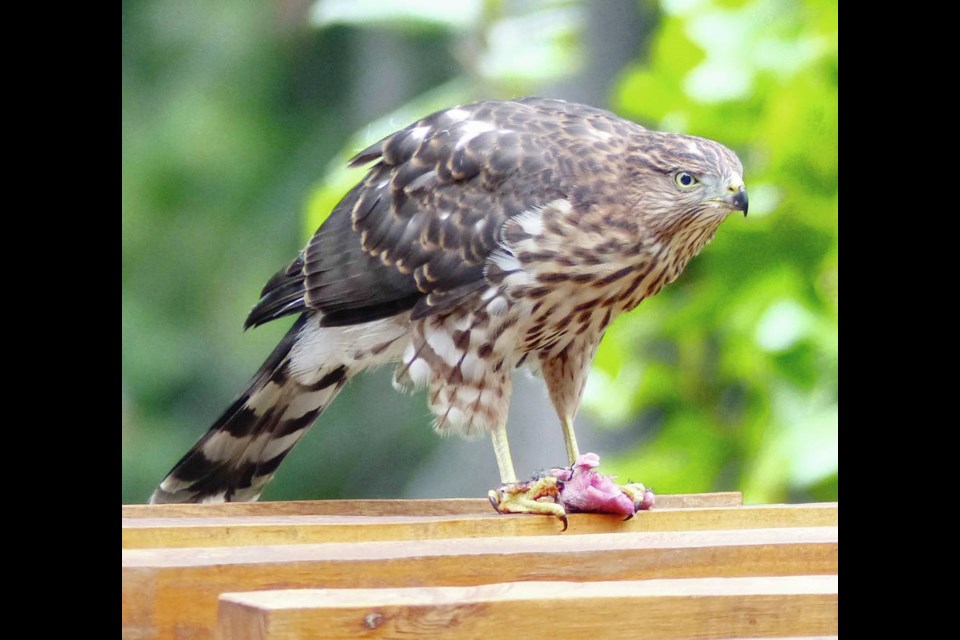Heavily featured in neighbourhood news this summer has been a pair of hawks nesting in a giant fir tree across the street from my home.
Daphne pointed out the nest to me, and described a sighting of one of the hawks feeding on what looked like a bunny in a huge arbutus tree next door to me.
Not wishing harm to any little creature, I still do wonder whether the hawk’s prey might have been the rabbit that chomped down earlier on young sunflowers in the front garden, nibbling into non-existence the toppled stems and foliage and leaving only bare lower stems that were presumable too tough for tender palates.
For a while the hawks were in my garden almost every day. One morning, I watched one of them perched in a small apple tree in a front corner of the garden. That big bird in the small tree looked almost unreal, more like a hawk decoy set up in gardens to scare away various small animals and birds that can damage certain plantings.
The hawk swept down from the tree to snatch something that let out a feeble squeak. I hoped it was not one of the nuthatches that have been active in the garden this summer.
Then Heather came to visit one afternoon. Before she left, we set out on a tour of the back garden but were stopped suddenly at the stunning sight of the two huge adult hawks perched on an arbour beside the back lawn.
They were side by side, one of them feeding on a mouse. It wasn’t long before the other hawk flew at the feeding one and took its turn at the mouse before they both flew off, mouse in feet.
Next in the neighbourhood hawk saga came the babies — two of them, cavorting on the lawn in Kim and Bob’s garden directly across the street. They live next door to the nest.
From the distinctive white and black banding of the tail feathers and a photo in Lone Pine Publishing’s Compact Guide to British Columbia Birds, I think the birds are Cooper’s hawks. These hawks prey on birds and small mammals, which they capture with their feet and kill by repeated squeezing.
There’s your “Nature, red in tooth and claw” tale for today. You’re welcome.
The bee corner. At a corner of one of the vegetable plots, a collection of self-sown flowers appeared, grew, bloomed, and spilled over onto a pathway. They were pert and pretty for a while, before they began looking overgrown and untidy. By mid-July it seemed time to remove them. But I could not.
The little congregation of flowers that had planted themselves were constantly crowded with bees. The orange California poppies appeared to be the big draw, though the bees also busied themselves in the blue borage and the larkspur.
Patches of flowers in the food garden are cheerful, and useful. Many attract and feed pollinating insects like bees and other beneficial insects that help to create a healthy balance in gardens by preying on insect pests.
Consciously noticing which flowers attract the most bees is a practice well worth fostering. I’ve noted the corner flowers and will certainly be letting more California poppies and borage plants self-sow to bloom and support bee populations in the coming years.
That no-maintenance corner display of flowers has been effectively highlighted by a companion planting of sweet potatoes with dark purple foliage.
Abkhazi invitation. Abkhazi Garden, 1964 Fairfield Rd. in Victoria, has expanded its Artist in the Garden program this year to Mondays through Thursdays from 11 a.m. to 4 p.m., through the summer. Artists are welcome to sketch and paint in the garden during these times. Anyone interested in participating is asked to contact Cherie at [email protected] for more information.
VHS meeting. As part of their 100th anniversary celebration, the Victoria Horticultural Society is hosting a special Zoom meeting on Saturday, Aug. 21, from 11 a.m. to 12;30 p.m. James Alexander-Sinclair, one of the most sought-after garden designers in the U.K., will explore Gardening in a Changing World. James Alexander-Sinclair writes a regular column in Gardner’s World magazine and is currently vice-president of the Royal Horticultural Society. Drop-in fee for non-members is $10. To register, visit vichortsociety.org.



